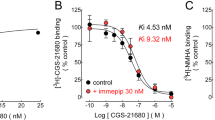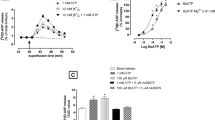Summary
-
1.
Adenosine analogues inhibit calcium-dependent K+-evoked release of [3H]norepinephrine from guinea pig cerebral cortical and hippocampal vesicular preparations. Inhibition requires high concentrations (100µM) of the adenosine analogues and is abolished in the presence of high concentrations (2 mM) of calcium ions. The inhibitory effect of 2-chloroadenosine is blocked by theophylline. The structure activity profile (N 6-d-phenylisopropyladenosine ≥N 6-l-phenylisopropyladenosine ≥ 2-chloroadenosine >N 6-cyclohexyladenosine, adenosine 5′-cyclopropylcar-boxamide) is not that expected of either A1 (high-affinity) or A2 (low-affinity) adenosine receptors.
-
2.
Calcium-dependent K+-evoked release of [3H]dopamine from guinea pig striatal vesicular preparations is inhibited by apomorphine. However, only 2-chloroadenoine causes an inhibition of K+-evoked release of [3H]dopamine. Other adenosine analogues such asd- andl-phenylisopropyladenosine and adenosine 5′-cyclopropylcar-boxamide cause a facilitation of K+-evoked release. The facilitation is abolished or reduced in the presence of high concentrations (2 mM) of calcium ions. The sites of action of adenosine analogues do not appear to have structural requirements identical to those expected of A1 (high-affinity) or A2 (low-affinity) adenosine receptors.
-
3.
The results indicate that adenosine analogues can have either inhibitory or facilitory effects on K+-evoked release of catecholamines from central synaptic terminals.
Similar content being viewed by others
References
Bruns, R. F. (1980). Adenosine receptor activation in human fibroblasts: Nucleotide agonists and antagonists.Can. J. Physiol. Pharmacol. 58673–691.
Bruns, R. F., Daly, J. W., and Snyder, S. H. (1980). Adenosine receptors in brain membranes: Binding of N6-cyclohexyl[3H]adenosine and 1,3-diethyl-8-[3H]phenylxanthine.Proc. Natl. Acad. Sci. USA 775547–5551.
Cooper, D. M. F., Londos, C., and Rodbell, M. (1980). Adenosine receptor-mediated inhibition of rat cerebral cortical adenylate cyclase by a GTP-dependent process.Mol. Pharmacol. 18598–601.
Daly, J. W., Bruns, R. F., and Snyder, S. H. (1981). Adenosine receptors in the central nervous system: Relationship to the central actions of methylxanthines.Life Sci. 282083–2097.
Dunwiddie, T. V., and Hoffer, B. J. (1980). Adenine nucleotides and synaptic transmission in thein vitro rat hippocampus.Br. J. Pharmacol. 6959–68.
Ebstein, R. P., Seamon, K., Creveling, C. R., and Daly, J. W. (1982). Release of norepinephrine from brain vesicular preparations: Effects of an adenylate cyclase activator, forskolin, and a phosphodiesterase inhibitor.Cell. Mol. Neurobiol. 2179–192.
Enero, M. A., and Saidman, B. Q. (1977). Possible feedback inhibition of noradrenaline release by purine compounds.Naunyn-Schmiedeberg Arch. Pharmacol. 29739–46.
Gustafsson, L., Hedqvist, P., Fredholm, B. B., and Lundgren, G. (1978). Inhibition of acetylcholine release in guinea pig ileum by adenosine.Acta Physiol. Scand. 104469–478.
Gustafsson, L., Fredholm, B. B., and Hedqvist, P. (1981). Theophylline interferes with the modulatory role of endogenous adenosine on cholinergic neurotransmission in guinea pig ileum.Acta Physiol. Scand. 111269–280.
Harms, H. H., Wardeh, G., and Mulder, A. H. (1978). Adenosine modulates depolarization-induced release of3H-noradrenaline from slices of rat brain neocortex.Eur. J. Pharmacol. 49305–308.
Harms, H. H., Wardeh, G., and Mulder, A. H. (1979). Effects of adenosine on depolarization-induced release of various radiolabelled neurotransmitters from slices of rat corpus striatum.Neuropharmacology 18577–580.
Hedqvist, P., and Fredholm, B. B. (1976). Effects of adenosine on adrenergic neurotransmission: Prejunctional inhibition and postjunctional enhancement.Naunyn-Schmiedeberg Arch. Pharmacol. 293217–224.
Hollins, C., and Stone, T. W. (1980). Adenosine inhibition ofγ-aminobutyric acid release from slices of rat cerebral cortex.Br. J. Pharmacol. 69107–112.
Hom, G. J., and Lokhandwala, M. F. (1981). Presynaptic inhibition of vascular sympathetic neurotransmission by adenosine.Eur. J. Pharmacol. 69101–106.
Kahn, M. T., and Malik, K. U. (1980). Inhibitory effect of adenosine and adenine nucleotides on potassium-evoked effux of [3H]-noradrenaline from the rat isolated heart: Lack of relationship to prostaglandins.Br. J. Pharmacol. 68551–562.
Kamal, L. A., Arbilla, S., and Langer, S. Z. (1981). Presynaptic modulation of the release of dopamine from the rabbit caudate nucleus: Differences between electrical stimulation, amphetamine and tyramine.J. Pharmacol. Exp. Ther. 216592–598.
Kuroda, Y. (1978). Physiological roles of adenosine derivatives which are released during neurotransmission in mammalian brain.J. Physiol. (Paris) 74463–470.
Londos, C., Cooper, D. M. F., and Wolfe, J. (1980). Subclasses of external adenosine receptors.Proc. Natl. Acad. Sci. USA 772551–2554.
McNeal, E. T., Creveling, C. R., and Daly, J. W. (1980). Cyclic AMP-generating systems in cell-free preparations from guinea pig cerebral cortex: Loss of adenosine and amine responsiveness due to low levels of endogenous adenosine.J. Neurochem. 35338–342.
Michaelis, M. L., Michaelis, E. K., and Myers, S. L. (1979). Adenosine modulation of synaptosomal dopamine release.Life Sci. 242083–2092.
Mueller, A. L., Mosimann, W. F., and Weiner, N. (1979). Effect of adenosine on neurally mediated norepinephrine release from the cat spleen.Eur. J. Pharmacol. 53329–333.
Muller, M. H., and Paton, D. M. (1979). Presynaptic inhibitory actions of 2-substituted adenosine derivatives on neurotransmission in rat vas deferens. Effects of inhibitors of adenosine uptake and deamination.Naunyn-Schmiedeberg Arch. Pharmacol. 30623–28.
Paton, D. M. (1980). Presynaptic inhibition of neurotransmission in rat vas deferens by 2-(p-methoxyphenyl)-adenosine, ethyl adenosine-5′-carboxylate and N-cyclopropyl adenosine-5′-carboxamide.J. Pharm. Pharmacol. 32133–134.
Paton, D. M. (1981). Structure-activity relations for presynaptic inhibition of adrenergic and cholinergic transmission by adenosine: Evidence for action on A1 receptors.J. Autonom. Pharmacol. 1287–291.
Phillis, J. W. (1977). The role of cyclic nucleotides in the CNS.Can. J. Neurol. Sci. 4151–195.
Sattin, A., and Rall, J. W. (1970). The effect of adenosine and adenine nucleotides on the cyclic adenosine 3′,5′-phosphate content of guinea pig cerebral cortex slices.Mol. Pharmacol. 613–23.
Schwabe, U., and Trost, T. (1980). Characterization of adenosine receptors in rat brain by (−)[3H]N6-phenylisopropyladenosine.Naunyn-Schmiedeberg Arch. Pharmacol. 313179–187.
Silinsky, E. M. (1980). Evidence for specific adenosine receptors at cholinergic nerve endings.Br. J. Pharmacol. 7157–64.
Silinsky, E. M. (1981). On the calcium receptor that mediates depolarization-secretion coupling at cholinergic motor nerve terminals.Br. J. Pharmacol. 73413–430.
Smellie, F. W., Daly, J. W., Dunwiddie, T. V., and Hoffer, B. J. (1980). The dextro and levorotary isomers of N-phenylisopropyladenosine: Stereospecific effects on cyclic AMP-formation and evoked synaptic responses in brain slices.Life Sci. 251739–1748.
Snyder, S. H., Katims, J. J., Annau, Z., Bruns, F. R., and Daly, J. W. (1981). Adenosine receptors and behavioral actions of methylxanthines.Proc. Natl. Acad. Sci. USA 783260–3264.
Stone, T. W. (1981). Physiological roles for adenosine and adenosine 5′-triphosphate in the nervous system.Neuroscience 6523–556.
Taylor, D. A., and Stone, T. W. (1980). The action of adenosine on noradrenergic neuronal inhibition induced by stimulation of locus coeruleus.Brain Res. 183367–376.
Van Calker, D., Muller, M., and Hamprecht, B. (1979). Adenosine regulates via two different types of receptors, the accumulation of cyclic AMP in cultured brain cells.J. Neurochem. 33999–1005.
Vanhoutte, P. M., Collis, M. G., Janssens, W. J., Verbeuren, T. J. (1981). Calcium dependence of prejunctional inhibitory effects of adenosine and acetylcholine on adrenergic neurotransmission in canine saphenous veins.Eur. J. Pharmacol. 72189–198.
Vizi, E. S., and Knoll, J. (1976). The inhibitory effect of adenosine and related nucleotides on the release of acetylcholine.Neuroscience 1391–398.
Wakade, A. R. (1979). Modulation of3H-norepinephrine release in the rat hypothalamus and cortex by adenosine. InAdvances in the Biosciences, Vol. 18 (Langer, S. Z., Starke K., and Dubocovich, M. L., Eds.), Pergamon Press, New York, pp. 377–383.
Walker, J. E., Goodman, P., Jacobs, D., and Lewin, E. (1978). Uptake and release of norepinephrine by slices of rat cerebral cortex: Effect of agents that increase cyclic AMP levels.Neurology 28900–904.
Williams, M., and Risley, E. A. (1980). Biochemical characterization of putative central purinergic receptors by using 2-chloro[3H]adenosine, a stable analog of adenosine.Proc. Natl. Acad. Sci. USA 776892–6896.
Wu, P. H., Phillis, J. W., Balls, K., and Rinaldi, B. (1980). Specific binding of 2-[3H]chloroadenosine to rat brain cortical membranes.Can. J. Physiol. Pharmacol. 58576–579.
Author information
Authors and Affiliations
Rights and permissions
About this article
Cite this article
Ebstein, R.P., Daly, J.W. Release of norepinephrine and dopamine from brain vesicular preparations: Effects of adenosine analogues. Cell Mol Neurobiol 2, 193–204 (1982). https://doi.org/10.1007/BF00711147
Received:
Revised:
Accepted:
Issue Date:
DOI: https://doi.org/10.1007/BF00711147




